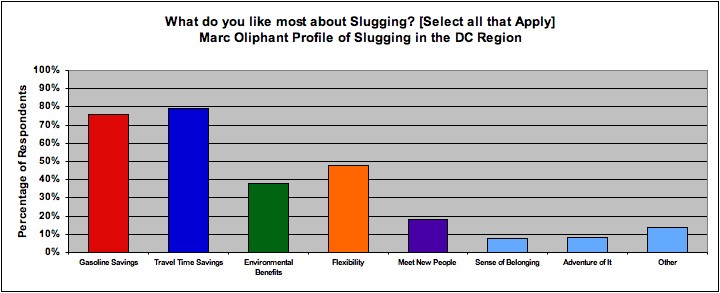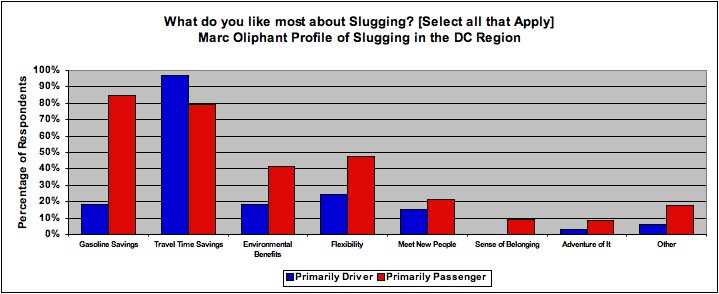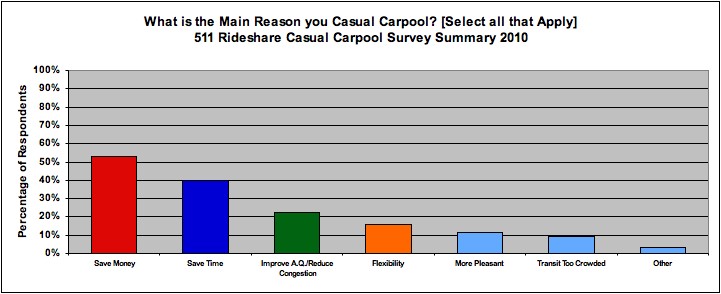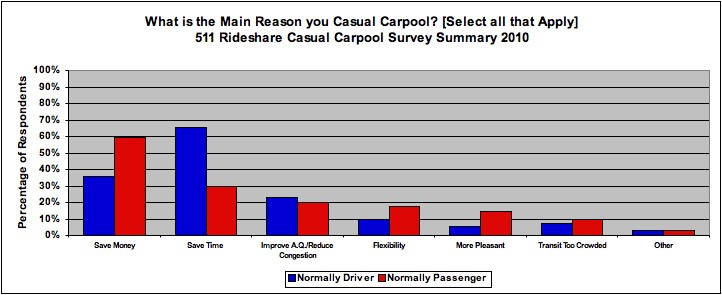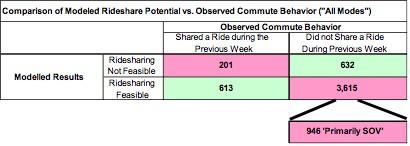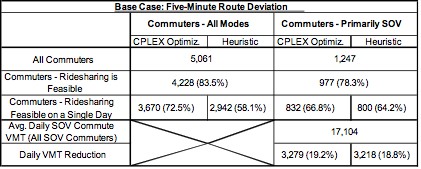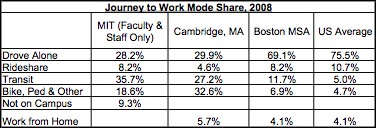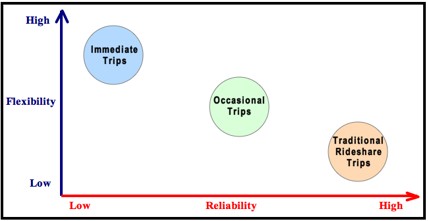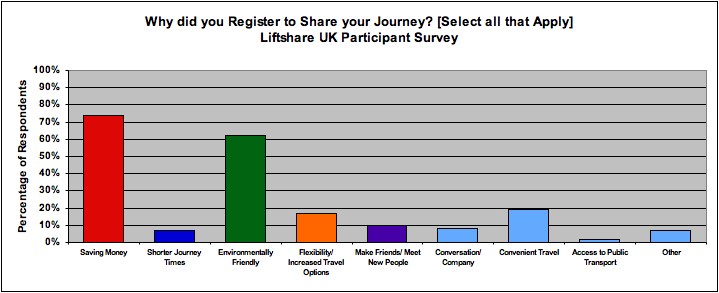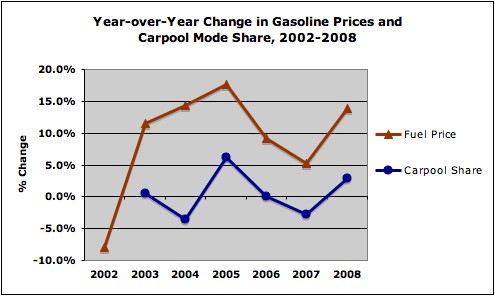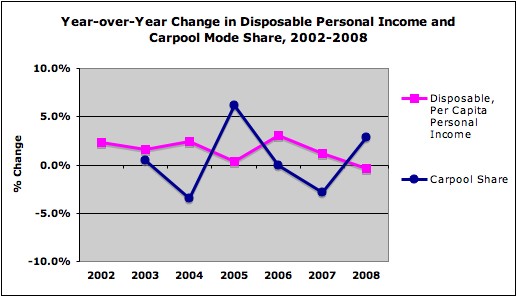A four step analytical approach was undertaken to estimate ridesharing potential at MIT: (1) MIT commuter survey preparation, (2) spatial analysis of commuter trips, (3) application of realistic trip characteristic filters, and (4) selection of feasible pairings.
Several important assumptions have been made during this analysis.
First, this approach assumes that only two-person carpools are possible. This assumption was made to simplify the matching process, however it is not believed to significantly affect the results. The complexity of identifying a third or fourth rideshare participant with a similar schedule and the additional travel time burden of picking up another passenger is likely to limit the number of feasible rideshares with three or more people.
Second, the approach assumes that a driver is willing to deviate from their normal route to MIT to pickup a passenger at their residential location. The prospect of drivers and passengers meeting at a mutually beneficial intermediate destination was not considered. Once again, this assumption was made to simplify the matching process.
Third, it was assumed that when a driver deviates to pickup a passenger, the pickup time is zero. This assumption is certainly unrealistic and understates the commitment the driver is being asked to make. Even in instances where the passenger is prompt there is likely to be some perceived, or psychological, wait time experienced by the driver.
Fourth, the chaining of trips to and from campus were ignored. No information on trip chaining behavior was available in the survey.
Step 1 – MIT Commuter Survey Preparation
MIT undertakes a comprehensive commuter survey every two years to measure commuter preferences and changes in commuting over time. The survey is administered to most of the MIT community and includes responses from undergraduates, graduate students, faculty, academic staff and support staff. The City of Cambridge and the Commonwealth of Massachusetts require that the survey be conducted. For this analysis, the 2008 version of the survey was used.
In 2008, MIT had approximately 21,800 community members including faculty, research staff, support staff, graduate students and undergraduate students. Of the full community, approximately 16,600 on-campus members were invited to complete the survey. Of the 5,200 that were not invited, over half were MIT staff working at the Lincoln Labs facility in Lexington, MA, approximately 15 miles NW of the main Cambridge campus. Approximately 10,300 community members completed the survey, representing a response rate of 62%. Completed survey responses were further filtered to isolate only community members that (a) commute to MIT’s main campus for work, (b) live off-campus, (c) are either faculty or staff (students were eliminated from this analysis), and (d) had a residential address that could be properly geo-coded into a Latitude-Longitude value. Requirements (a) and (b) ensure that a commuting trip is taking place. Graduate and undergraduate students were eliminated from this analysis for several reasons. Undergraduates at MIT are required to live on-campus, or in Institute-sponsored, off-campus housing such as fraternities or sororities. The off-campus, undergraduate housing options are well served by the MIT-operated campus shuttle bus system. It was assumed that undergraduates would rarely, if ever, require a rideshare arrangement to travel to campus. Graduate students were eliminated because of the assumed variability of their daily schedules. The survey does ask for a community member’s arrival time on campus and departure time from campus, but only “on a typical day”. For graduate students, it was believed that responses to that question would be highly variable day to day and would reduce the value of the analysis. Further, graduate students have a much different pattern of residential selection than staff and faculty do. Students tend to live closer to campus, reducing their likelihood of choosing ridesharing as a mode of travel.
Two groups of commuters were identified for use in the feasibility analysis; (1) all commuters regardless of their mode of travel (labeled “All Modes”), and (2) those commuters that traveled to campus as a single occupant driver four or five times during the previous work week (labeled “Primarily SOV”). Note that the “Primarily SOV” group is a subset of the “All Modes” group. While portions of the “All Modes” group already commute using sustainable forms of transportation, they were included in the analysis to see what percentage of the MIT community could successfully be matched and could possibly participate in ridesharing. The “Primarily SOV” subset is the group of greater interest, as they are the ones whose potential travel behavior change would have the greatest impact on reducing VMT and reducing the need for on-campus parking.

Step 2 – Spatial Analysis of Commuter Trips
With 5,061 completed surveys by the targeted groups, including geo-coded residential locations, a spatial analysis of commuting trips to MIT was undertaken. A transportation network model of the greater Boston area developed in a previous academic course was used in conjunction with the TransCAD transportation modeling software package. The road network within the Boston model includes a value for congested travel time on every road link in the network, as calculated by an iterative traffic assignment process undertaken during a previous 4-step transport-modeling endeavor. Whereas the University of Toronto approach looked for clusters of commuters at the residential end using a GIS-buffer approach, this approach capitalizes on the availability of a congested road network that allows for the use of a least-cost travel time algorithm to assign commuters to a path they would most likely choose to get to MIT, if were seeking to minimize their travel time. In clearer terms, while the University of Toronto approach made matches based on residential proximity only, the proposed approach makes matches based on a route that commuters are likely to choose. The added benefit of this approach is that it allows for the matching of drivers and passengers mid-trip, along the driver’s path.
The 5,061 geo-coded commuter records were imported into TransCAD as a series of points. One additional point representing the main entrance to the MIT campus at 77 Massachusetts Avenue was added to the list. The commuter points were linked to the nearest roadway intersection on the network using a spatial join. A road network skim of travel time and travel distance was performed from all commuter points to all other commuter points. Since this procedure was essentially taking the travel time and distance from all 5,062 points to all other 5,062 points, it generated a database table with 25.6M. commuter pairings (5,062 x 5,062), many of which have real potential for ridesharing and some of which are not at all feasible. The third step, applying trip characteristic filters, is where only those rideshare pairings that are feasible are identified.
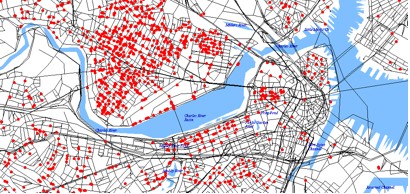
Step3 – Application of Trip Characteristic Filters
The third step involved filtering the millions of commuter pairings generated in TransCAD down to only those that could be reasonably expected to share rides. With the table of 25.6M. records, one must first determine the direct distance and travel time to MIT for all 5,061 commuters. Since MIT’s location was coded as one of the records, a process of extracting a subset of the existing data table (those pairings where the MIT node was the destination) was used. One can think of these as the SOV distances and travel times for a driver and passenger in a potential rideshare arrangement, if they both chose to drive to campus alone. In the rideshare diagram shown below, these are the segments labeled ‘DirectD’ and ‘DirectP’ for commuters #1 and #2 respectively. The next step involved calculating the carpool distance and travel time. Carpool values were assumed to be the distance/time from the ‘driver’s’ residence to the ‘passenger’s’ residence (the segment labeled ‘Leg1’), plus the distance/time from the ‘passenger’s’ residence to MIT (the segment ‘DirectP’). At this step in the analysis, no restrictions were placed on rideshare roles, so commuters could be identified as drivers or passengers. The difference in values between the ‘driver’s’ direct trip to MIT (‘DirectD’) and the carpool distance/time (‘Leg1’ plus ‘DirectP’) is a particularly important trip characteristic filter that will be described later in this section.
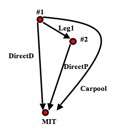
A series of filters were applied to isolate only those commuter pairings that were believed to be feasible for ridesharing. The following list outlines the filters used and the rationale for applying them.
(a) The ‘driver’ is only willing to accept a deviation of five minutes (5 minutes) or less from their normal drive-alone travel time. This was the difference between the ‘DirectD’ segment travel time and the calculated carpool travel time outlined previously. A five-minute threshold was chosen based on previous rideshare survey findings. Li et al. (2007) found that 75% of 2-person carpools in Texas involved a deviation of five minutes or less. Attanucci (1974) previously found that 51% of members of the MIT community were willing to deviate no more than five minutes and an additional 29% were willing to deviate between five and ten minutes. Note that this filter does not restrict the direction of travel. If a passenger is two minutes in the opposite direction from the driver’s residence (and thereby adds a total of four minutes to the driver’s journey), the filter suggests that that trip is as likely to occur as one that requires a four minute deviation off of the driver’s main route to MIT. While this is assumed not to be a substantial burden on drivers it could very well be. As such, sensitivity analyses were also performed at 2 minute and 10 minute deviation thresholds.
(b) The ‘driver’ is unwilling to spend more than 150% of his/her drive-alone travel time to rideshare to campus. This filter only affects those that are already relatively close to MIT. For example, if a driver normally has an eight-minute commute to campus, this filter will limit the feasible set of passengers to those that add four minutes or less to the driver’s journey. For commutes longer than 10 minutes, the “five-minute deviation threshold” filter described above supersedes this filter. As such, this filter eliminates relatively few pairings, but pairings that are quite unlikely to represent desirable rideshare arrangements.
(c) ‘Passengers’ within 1 mile of campus are excluded from consideration. Within a distance of 1 mile, the attractiveness of walking, cycling and transit should be much higher than the attractiveness of ridesharing.
(d) The ‘driver’ in the rideshare arrangement must have access to a vehicle. The 2008 MIT Commuter survey asks respondents whether they have access to a private vehicle for daily commuting.
(e) The ‘driver’ and ‘passenger’ in a rideshare arrangement must arrive on campus and depart from campus within the same 30-minute period. The 2008 survey asks participants to provide their arrival/departure time to/from campus on “a typical day”. Respondents are provided with 30-minute blocks of time (7:00-7:29am, 5:30-5:59pm, etc.) and are asked to choose only one block. The implication of having both arrival and departure times matching for both the ‘driver’ and ‘passenger’ is that roundtrip, rideshare opportunities are assumed.
Step 4 – Selection of Feasible Pairings
At this point, those commuter pairings that are believed to be feasible have been identified. However, there are often cases where a driver has the option of picking up multiple passengers, or passengers can be matched up with multiple drivers. Adding to the complexity, there is nothing stopping a commuter from being a driver in one pairing and a passenger in another pairing. Since the assumption is that only two people can share a ride at any given time, this step requires the specification of a decision variable to select ‘feasible’ pairings, such that no commuter (driver or passenger) is paired up more than once on any given day. In more general terms, one can think of the output of Step 3 as the full list of feasible pairings that are possible over the course of a week or month, whereas the purpose of Step 4 is to select only those pairings that are possible on any single day. This final step is essentially seeking to maximize the number of members of the MIT community that can be paired together by employing an optimization process.
Two approaches were used to identify ‘feasible’ pairings; one approach used the CPLEX algorithm in the OPL Studio software suite, and the second option involved a simple heuristic approach using a standard spreadsheet program. The CPLEX approach involved solving a general network flow problem with side constraints to ensure that a commuter was not paired up as both a driver and a passenger in separate pairings. For the “All Modes” subset of commuters, the objective function used was the maximization of commuter pairs. For the “Primarily SOV” subset, the objective function used was the maximization of VMT savings.
The heuristic approach began by sorting the list of pairings from highest to lowest potential VMT savings, and then employed an iterative approach of selecting drivers and passengers. The first driver-passenger pair with the largest VMT savings was “activated”, and both commuters were removed from consideration in all further pairings. Moving onto the next pairing, both the driver and passenger were checked to see if they were “available” for matching. If either the driver or passenger were previously “activated”, the selected pairing was discarded and the next pair was considered. This process was repeated for all pairings in the list. The decision variable for both subsets of commuters (“All Modes” and “Primarily SOV”) is the maximization of commuter pairs, but implicitly VMT savings are also considered given the initial sorting that took place.
The two approaches have different strengths and weaknesses. The CPLEX optimization approach provides an outcome that is more robust, but requires writing the problem statement in the proprietary language of the software, which is relatively time consuming. The heuristic approach is quite simple to implement in commonly available spreadsheet programs, is not particularly time consuming, but provides a sub-optimal set of feasible pairings. Whereas the heuristic approach may select a single driver-passenger pair that has relatively high VMT savings, the CPLEX approach may identify two pairings, each with relatively smaller VMT savings, but where the total savings from both pairings are larger than the single, high VMT pairing. For this analysis, both the CPLEX and heuristic results will be reported.
Uncategorized | No Comments »
